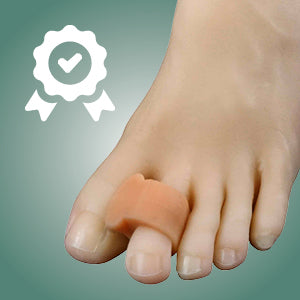Have you noticed a bulge on the side of your foot right at the base of your big toe or pinky toe? Does the bump seem to swell, be red, and tender to the touch? If so, you may be suffering from a very common foot condition called a bunion. An estimated 23 percent of all people over age 18 have experienced bunion pain, and this foot issue tends to become more common as we age.
Bunions, known as hallux valgus in the medical world, are bony deformities of the joint at the base of a person’s big toe. Pronation of the foot causes it to become unstable and this results in the muscles in the foot to arch and bend the impacted toe. They may push into the toe next to it resulting in even further pain and irritation. The condition may be worsened by wearing shoes that are too small, point-toed shoes, or high-heeled shoes. Women are more likely to develop bunions than men, partially because of the shoes they wear. Smaller bunions may develop at the base of the pinky toe and are often called bunionettes.
Symptoms of Bunions
When it comes to bunionettes or bunions, the symptoms may be varied, but there are some symptoms that tend to be the most common. These include:
- A bulging bump at the base of the big toe or pinky toe.
- Redness, soreness, or swelling near the big toe or pinky toe joint.
- Pain near or in the big toe or pinky toe.
- Calluses on the feet.
- Restricted movement of the affected toe/joint.
Treatment for Bunion Pain
Of course, surgery is an option for bunions and bunionettes, but it is always best to use surgery as a last result if there are other options. The downsides to surgical treatment include the bunion returning after surgery, the surgery overcorrects the problem causing issues or doesn’t correct it enough, or the affected toe has decreased mobility after surgical treatment.
The good news is that there are non-surgical treatments available for bunions. If treated early with these methods, bunion pain may be greatly reduced. Bunions develop slowly over time and eventually, if left untreated, result in changes in the bone and eventually the bunion bump. The deformity can continue to increase and make it painful to wear shoes or even walk. That’s where our toe separators, bunion pads, and bunion guards can help.
- Toe Separators – This non-surgical treatment can help align the big toe and relieve pressure on the bunion. Our toe spacers are made out of silicone gel that is washable and reusable. They are soft and barely noticeable when placed to fit over your toe or sit in the gap between your toes to keep them from drifting together. The gentle realignment can prevent bunions from getting worse and provide comfort and relief during the day.
- Bunion Pads – These disposable pads are made to protect the bunion from rubbing on the shoes. They help reduce pressure, chafing, and friction, and must be replaced daily. They are thicker and provide more comfort than most bunion protectors and have a waterproof adhesive that will last all day through all your activities but is safe for even the most sensitive skin.
- Bunion Guards – This non-surgical bunion treatment also protects and cushions your bunion, but is made from the same soft, silicone gel as the toe separators so they are reusable and washable. The bunion guards fit comfortably over your big toe and provide protection and cushioning of your bunion. It will not come loose or shift out of place because it conforms to the unique shape of your foot. They’re so comfortable you’ll forget that you are wearing them, no matter what kind of shoes you are wearing.
When you are suffering from bunion pain, every single step can be excruciating as the bunion presses against the side of your shoe. Because of this, many people change the way they step which can result in a rippling effect that can cause pain and problems in their knees, hips, legs, and back. That’s why ZenToes created these non-surgical treatment options so you can stay on the go, comfortably, pain free all day!


